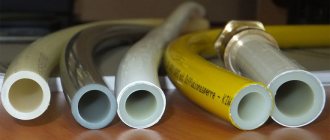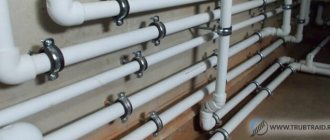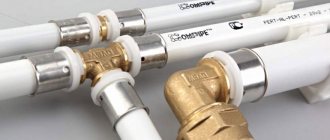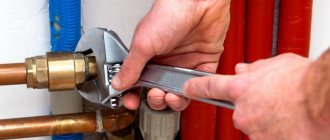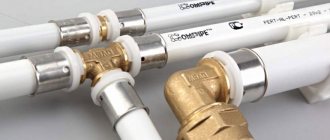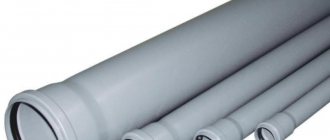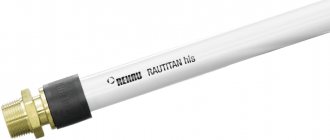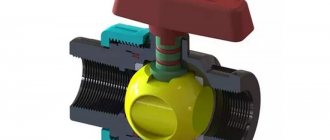Decorative overlays for pipes are details that allow you to turn elements of engineering communications that do not fit into the interior of the premises into an organic component of the overall design. For various reasons, it is necessary to resort to decoration in order to hide protruding structures that disrupt the overall impression of the room, without interfering with their normal functioning.
Decorative trims are used to cover the passage of a pipe through the floor or ceiling
Decorating methods for lovers of thoroughness
If the heating system is so boring that you want to completely hide it from view, then the following solutions will suit you. They are somewhat more complex than those given above, largely due to the fact that they are intended for a luxurious, expensive interior, for which homemade creativity is strictly contraindicated.
Stationary box with lattice lid
False decorative columns are made of polyurethane. Easy to install: fastened with liquid nails. Easily dismantled if necessary to inspect heating pipes. Organically fit into an elegant interior; a creative solution for decorating a riser.
Drywall is an interesting solution for those who are not looking for easy ways
This is because to get an effective result, it is important to have the skill to work with a serious electric tool (like a screwdriver)
The basis of the box is a structure made of galvanized profiles
After facing with plasterboard, the structure is puttied and finished in any way
This is a capital structure that completely hides the heating system behind it. Boxes decorated with stone and lined with colored tiles look great.
Types and designs of linings
Overlays are divided into two types:
boxes, covers, screens for pipes;
rings, sockets and plates for passing communications through walls and ceilings.
Finished rings and plates consist of two halves that are connected to each other by snapping. They are attached to the wall or floor using a small amount of any glue. Material: plastic or wood. They cover well the gaps that form in the places where pipelines pass when laying the laminate.
Finished boxes:
Tall (up to 20 cm or more) polyvinyl chloride, steel, aluminum, and even wooden baseboards are very common; they have channels through which any small communications can be passed, as well as wires, communication cables, Internet, etc. Such structures are also made from particle boards;
rectangular PVC moldings intended for placement on the wall;
almost flat small moldings - they cover communications recessed into grooves in the plaster;
traditional plastic PVC boxes (cable ducts);
metal prefabricated casings;
prefabricated boxes made of valuable wood species. Presentable and expensive option.
Wooden boxes are secured using special brackets. Metal and plastic casings are attached using dowels.
Options for making homemade covers:
metal or wooden frame, plasterboard sheets + putty and painting or wallpapering (optimal for plasterboard ceilings on several levels);
- metal or wooden frame, drywall + tiling;
- the frame can be sheathed with laminate, glass, or covered with plastic panels;
- Chipboard, MDF, LDF, HDF (medium, low, high density particle boards), thick plywood + painting or varnishing, lamination, pasting with self-adhesive PVC film;
- “for an amateur” option - bamboo trunks sawn lengthwise are cleared of partitions and glued to pipes, painted with a natural light green color, they can be decorated with artificial greenery;
pasting with tree bark, sometimes with other decorative materials.
Do-it-yourself manufacturing and installation
Making a decorative product on your own is a doable task. The materials chosen are wood, plasterboard, brickwork, and plastic linings. When making a box from brickwork, one should take into account the impossibility of disassembling such a structure without destroying the integrity of the bricks (for example, when a battery leaks). Plasterboard boxes easily hide communications; they combine ease of processing, convenient operation, and low price. Installation of such boxes includes several stages:
- Accurate measurements of heating communications to determine the size of the lining.
- Assembly of the structure. The main profile is attached to the floor, and the sheathing is assembled with support on it.
- The cut plasterboard parts are sanded with a plane, applied to the frame, and secured with self-tapping screws.
- The gaps between parts of the structures are covered with putty. The surface of the box is primed and finished.
Installation of overlays
Radiator finishing methods
Currently, decorative cast iron heating radiators with a three-dimensional design are produced, which are real works of art.
The cost of such accessories is high, so to improve the aesthetics of classic radiators, the following more affordable methods are popular:
- making a box or screen;
- artistic painting.
Decorative box for radiator
The design of the box differs from the screen structure in the presence of not only front and top panels, but also side walls. Both types of decorative shells can be attached with brackets to the wall or simply placed (hung) on the radiator
Such decorative elements are not only produced in a universal design, suitable for a certain number of sections, but are also made to individual orders, taking into account the dimensions of the radiator, its location, the method of fixing the box and the material of the accessory.
Regardless of the design and material, all decorative boxes for radiators of the heating system must have the following characteristics:
- strength - products must be resistant to mechanical stress common in everyday life;
- sufficient heat resistance - the box should not be deformed under the influence of heat;
- good heat dissipation - the design of the accessory must ensure constant air circulation to heat it;
- environmental friendliness and safety – the screen material should not emit harmful substances when heated;
- aesthetics;
- ease of installation, dismantling and daily maintenance.
When making wooden boxes, preference is given to oak or beech wood, which is little susceptible to deformation from heat.
Metal casings and screens are made of galvanized or stainless steel with classic or decorative perforation. Products based on a metal frame covered with steel mesh are common.
Knowing the list of requirements for protective boxes, when purchasing this accessory, all that remains is to choose a product whose design will harmoniously fit into the overall interior of the room.
Making a decorative box with your own hands
If the goal of making a decorative overlay is to increase the aesthetics of the heating system, then it is better to make the casing from wood or its budget substitutes (MDF, laminated chipboard), which are easier to process than metal.
Work begins with determining the dimensions of the box, the distance from the walls of which to the radiator should be at least 3 cm.
Then the frame is made - from wooden blocks or CD profiles. The bars are fastened together with self-tapping screws using the insertion of rectangular gussets between the posts perpendicular to each other for structural rigidity. CD profiles can also be fastened with metal screws or using blind rivets.
The frame design must include brackets for mounting to the wall or legs for installation on a special platform on the floor.
The front (front) and side panels are made according to the dimensions of the frame, for which they first assemble frames from the MDF frame profile for the sashes.
Then the outer cladding material is selected (rationally - MDF sheet), in which, after cutting to size with a core drill, holes are made for air circulation. The sheets are inserted into frames, and the finished panels are attached to the frame.
Installation of plugs
Next, it is worth considering the principle of installing the plug. Most often, this process is not accompanied by any difficulties, therefore, anyone can handle this task without having any special skills.
Each individual type of plug is mounted slightly differently due to its design features.
The main thing is to adhere to these rules:
- To achieve normal tightness of the threaded connection, you should use some kind of sealant, for example, fum tape.
- If you are installing a pneumatic plug, you should adhere to safety rules and monitor the volume of air supplied, otherwise the part may burst.
- Installing an elliptical plug requires knowledge of welding and taking into account all safety regulations when operating this device.
- The flange blank mounting bolts must be exactly the same size as the holes drilled for them, otherwise the seal will be compromised and the plug will not function properly.
How to decorate or hide pipes
If the system is already installed and needs to be decorated, the following methods are most often used:
- painting;
- special rings;
- decorative coatings;
- cornices and curtains with drapery.
There is also the possibility of masking communications in boxes and false walls. For the manufacture of boxes, plasterboard, MDF, wall panels, laminate, and parquet board structures are used. False walls are also made from plasterboard or wall panels, but they have a more complex structure than a frame. A sheathing and a heat insulator are attached to the wall, and then sheathed with finishing material. The disadvantage of camouflage in boxes and false walls is one, but significant: in the case of repairs to communications, the entire structure must be destroyed.
You can hide the pipe using plasterboard construction
Painting: inexpensive and effective
This is a cheap and easy way to decorate heating pipes. If you follow the technology, they will look neat and unobtrusive. With the right choice of tone, they will “merge” with the walls and become almost invisible. You can only paint cold pipes when the heating is turned off. In warm conditions, the composition will dry too quickly, streaks will be visible and unevenness will appear.
At the preparatory stage, it is necessary to thoroughly clean the metal of old paint. This is best done with a hair dryer and a spatula. Alkyd enamel is ideal for finishing. If necessary, the paint can be thinned with white spirit. It is not necessary to prime surfaces. After cleaning the remnants of the old coating, dust and dirt, you can immediately apply a new one. Pipes should be painted in two layers.
If the surface is well cleaned, the paint lays down in an even layer, without drips or unevenness.
Stylish decorative rings for heating pipes
Heating pipe rings are designed for installation with suspended ceilings. Their function is to close the holes for the risers, which cannot be masked with a regular baseboard. Rings can be used with any type of ceilings and floors; a variety of models allows you to choose an option suitable for any type of coating.
There are wooden collapsible models, plastic decorative covers for heating pipes - rosettes. The range of colors and textures is huge. Smooth rings in neutral colors are universal and fit into both a classic and ultra-modern room design style.
Decorative rings and linings for heating pipes are very diverse, you can always choose the ones suitable for a specific room
Decorative coating: unusual design of ordinary pipes
You can decorate pipes in a very original way, if you don’t hold back your flight of fancy. Recently, the idea of wrapping a rope made of natural fibers - hemp or jute - has been popularized. This decor for heating pipes looks original and is especially liked by fans of eco-style and country style. But not everything is rosy: this finish is a heat insulator, and can only be used in rooms where it is always very warm. In addition, pets do not miss the opportunity to chew and tear the material with their claws.
Another creative idea is homemade decorative linings for heating pipes made of bamboo. The trunk of the plant is split lengthwise and the halves are glued to the pipe. When finished, it looks like bamboo, growing from the floor to the ceiling. Ideally combined with full or partial finishing with natural fiber wallpaper, bamboo blinds, etc.
If you have a little time, effort, patience and a great desire to make a work of art out of your heating system, you can decorate the pipes using the decoupage technique, cover them with pebbles, shells, decorate with artificial flowers - everything is in your hands.
Painting on a heating pipe made using decoupage technique
Masking communications with curtains
You can cover the pipes without much effort - with curtains with drapery. The method is old, reliable, time-tested. It's simple: a ceiling cornice is attached to the entire width of the window wall, and the wall itself is completely draped with thick curtains. They cover risers from floor to ceiling. If desired, the upper and lower holes for the risers can be hidden with decorative collapsible rings. Such camouflage does not affect the temperature in the room, does not require the expense of carefully finishing the pipes themselves, and does not interfere with repairs in case of leaks.
Curtains cover the entire space from ceiling to floor and mask communications
Everyone has their own ideas about aesthetics, but all people have one thing in common – the desire for harmony. You can choose exactly the method of decorating or masking communications that seems most acceptable to you - painting, overlays, rings, curtains. The main thing is that the renovated home or office should be cozy and beautiful. The rest is a matter of taste. Choose!
Range
The variety of offers makes every buyer doubtful, but experts know how to make a choice. The first thing people pay attention to when buying a pipe plug is the material it is made of. During the manufacturing process the following is used:
- The simplest thing is metal. To do this, use brass or steel. Metal ones are suitable for those places where maximum strength is required - gas, water pipes. The main advantage is reliability. But there is also a minus - the product is subject to corrosive effects. Fittings made of brass are in demand more often.
- Plastic plugs for pipes. This is the most popular material today. Although disadvantages cannot be excluded - it changes shape when exposed to heat. Low price, found in indoor and outdoor installations. Not subject to corrosion.
- Chromed metal. Most often used as a decorative element. Quite expensive for the price. Because it shows itself as one of the most reliable materials and does not become rusty even with prolonged use. Those pipes that are used for water intake can be equipped with such an element.
- Rubber. No less used element. This plug for steel pipes prevents dust and dirt from entering the system. If it is necessary to withstand high pressure, then such a product is not used. Rubber is a plastic material and will not withstand high pressure. It will easily change its shape.
Its scope of application will depend on the material from which such an element is made. Today there are plugs for square pipes. Because any production does not stand still, and sometimes it is necessary to use non-standard solutions.
Types of decorative overlays
Decorative overlays differ according to their purpose, materials of manufacture, design and design.
Two types of linings are used to decorate pipes:
- sockets are used to disguise the location of the pipe passing through the flooring, wall or ceiling;
- boxes are used to decorate the heating pipes themselves.
When installing a heating system or redecorating a room, you have to cut holes for heating pipes in the floor covering, wall, and ceiling. Even a neatly made hole will be conspicuous and spoil the appearance of the room, because when finishing it is necessary to leave a gap of 1 cm.
During operation, the material used for finishing may shrink, contract and expand depending on the ambient temperature. If there is no gap, these processes can cause damage to the floor, wall or ceiling covering or heating pipe.
Installing a decorative rosette solves the problem by maintaining the required gap, but at the same time making it invisible. The place where the heating pipe passes through the floor, wall or ceiling becomes more aesthetically pleasing.
The pipes themselves, especially heating risers, also do not always fit into the interior. In the kitchen or bathroom they can be hidden behind furniture, household and plumbing fixtures; in other rooms this method may not be possible.
If pipes are forced to remain in sight, they not only spoil the overall impression of the situation. Very hot water most often circulates through the heating circuit, so it is easy to get burned if it comes into direct contact with the pipe. The use of decorative boxes solves both problems without reducing the functionality of the heating system.
Rings and boxes are made from:
- wood - the most environmentally friendly and stylish, but unstable to mechanical stress and very expensive;
- metal – durable, promote uniform heat distribution, they can be painted;
- plastic - strength, durability and resistance to high temperatures are lower than that of linings made from other materials, but the design options are much wider, so plastic decorative elements can be matched to any interior.
Rings and boxes can be decorated to look like parquet and laminate, stone, cork, or have other textures and a variety of colors.
Design Features
Sockets are made in the shape of a bowl, ring, oval, square or rectangle with rounded corners, with one or two round holes for a pipe. The dimensions of the holes correspond to the dimensions of standard pipes used for installation of heating systems. Plastic and metal sockets have a connector on one side, wooden ones consist of two halves and snap into place on both sides.
The detachable design of the socket makes it easy to use: just put the element on the pipe, slide it to the place where the floor, wall or ceiling passes and click into place. In addition, such pads can be removed when changing the coating or even during general cleaning. And after finishing the work, rinse, dry and reinstall.
Covers for heating pipes in the form of a box differ from conventional boxes for pipelines in that they do not have a guide channel to which the upper closing channel would be attached. A cover box is a U- or L-shaped gutter that is used to cover one or more pipes, securing it directly to the wall. U-shaped boxes are used on the plane, L-shaped boxes are used in corners.
In addition to the cross-sectional shape of the lining box, they differ in:
- the presence or absence of perforation,
- bend shape (radius, rounded or rectangular),
- edge design (sheet folding, corners outward or inward).
Perforated boxes reduce heat loss, while closed boxes create additional thermal insulation for pipes. There are many perforation options, you can choose any design.
To decorate pipes, use an overhead box of such a size that the walls of the box are at a distance of at least 5-7 mm from the walls of the pipes. This is necessary to prevent overheating and deformation of the box, and for normal circulation of hot air.
In addition, this will protect the pipe from mechanical influences and people from burns. Overhead boxes are attached directly to the wall using self-tapping screws or dowels, depending on the wall material.
What to consider when choosing a pipe plug
To choose and buy pipe plugs correctly, you should take into account many factors:
1. In the first place when selecting, there is a specific feature of the pipe operation:
- A plug for a gas pipe is an element on the quality of which the reliability and safety of the gas pipeline may depend. Elliptical-shaped plugs fall into this category. Threaded connections allow leakage even with minimal clearance;
- In heating and hot water supply, metal plugs are used. Plugs made from other materials may change their shape and lose strength when heated. The most reliable high-quality pipe plugs are made from metal (plastic and metal-plastic products are suitable for systems with cold water or for systems with low-temperature coolant);
- For water supply installations, products in the shape of an ellipse or flange plugs, as well as plugs with a threaded connection, are used. The main requirement for installing these fittings is correct installation.
2. The next stage of choosing a plug is the tasks that the product must solve:
- for temporary cutting off of coolant, fittings in the form of a flange and pneumatic plug are more suitable;
- for long-term overlapping of systems, metal products with threads or in the form of an ellipse are used;
- Decorative pipe plugs are purchased based on aesthetic preferences.
3. When choosing plugs, do not forget to take into account the material from which the pipe itself is made:
- a durable metal product is usually used as a plug for a cast iron pipe;
- For plastic pipes, plugs made of the same material are used.
4. Pipe parameters are another important factor influencing the choice of plugs:
- plugs for round pipes;
- plugs for square pipe;
- for pipes with a different cross-section, square-shaped products are used only as a decorative element;
- For each pipe, the plug is selected taking into account its parameters.
DIY decor and disguise
If there is no opportunity or desire to purchase ready-made elements for decorating pipes, then you can do something with your own hands. Think about the future design of the structure in advance, decide what color it will be
Pay special attention to the choice of finishing material. It must be resistant to heat, not deform, be easy to clean and not emit harmful compounds during operation.
Painting pipes
The easiest way is to paint the piping to match the color of the interior. If the paint is matched to the color of the walls, ceiling or floor, then the highway will be almost invisible against the background of the overall decoration of the room.
For work, you can use alkyd enamels and acrylic-based paints. For working in a room with normal humidity, a water-dispersion composition is suitable. All of these paints are resistant to high temperatures and do not emit toxic substances when heated.
Pipe decoration options:
- You can simply paint the pipelines to match the color of the walls. This way they will become less noticeable against the general background.
- A pipe that is painted along with the wall, but not in one color, but using patterns or a holistic ornament, looks much more interesting.
- You can wrap the pipes with jute or hemp rope before painting. This method has one significant advantage - additional insulation of the pipes in order to maintain the temperature of the coolant as it moves into the radiators.
Painting gives unlimited scope in terms of decorating heating lines. Another plus is that the paint color can be precisely matched to the color of the walls, which cannot be said about ready-made decor. However, among the disadvantages is the fragility of painting. Any paint will crack, peel or turn yellow over time, so the decorative layer will have to be renewed.
Decoupage
This method of decoration is distinguished by originality, uniqueness and great scope for realizing ideas. To decorate the surface, cut outs from newspapers, magazines, thin wallpaper, and napkins are used. The pictures cut along the contour are glued to the surface with suitable glue. After decorating the entire pipe and drying the adhesive mixture, the surface is covered with two layers of acrylic varnish.
The advantages of decoupage are as follows:
- originality and uniqueness of the patterned surface;
- the pipeline can become part of the decor of the room;
- additional protection of pipes from corrosion;
- minimum expenses;
- the pipeline can be wet cleaned.
The disadvantage of this method of decoration is associated with the deterioration of the heat transfer of the heating device, but in the case of a pipeline this is not a problem, because here, on the contrary, it is important to maintain the temperature of the coolant before it enters the radiator. The varnish layer needs to be renewed periodically to prevent it from cracking or peeling.
Drywall box
Instead of plastic boxes for heating pipes, you can use plasterboard structures. The advantage of this option is that the box can be made to accommodate communications of any size. First, a frame is built on the wall, covered with plasterboard, and then decorated with suitable finishing material.
The advantage of the technique is that it can be used in any room (even with high humidity). The design fits well into the interior of the room and becomes part of it.
But this technology has many more disadvantages:
- The work ahead will be long and painstaking. You need to buy all the necessary materials, cut them and secure them in the right place. During operation, a lot of dust and debris is generated. It is much easier and faster to install a ready-made box.
- After installing the structure, access to the heating distribution will be completely blocked. In case of leakage, the casing will have to be disassembled.
- If the walls were decorated earlier, then it is difficult to find the same finishing material for the box.
An interesting solution would be a plasterboard structure with stained glass lighting. Instead of the front panel of the box, frosted stained glass is installed, and LED lighting is installed behind it. Thus, it is possible to hide the heating pipes and decorate the room. The advantage of the stained glass design is that the glass can be removed if necessary to gain access to the pipes.
How to put a plug on a pipe
Installing a plug in a system without pressure
When there is no pressure, the plug is used to seal the system. Its installation guarantees fixation of the end. To do this, select an O-ring and insert a plug for PVC pipes.
Installing a plug in a pressurized system
For high-pressure networks made from polypropylene-based pipes, plugs are required, which have high strength indicators. To ensure reliable installation, plastic plugs for the profile pipe are mounted using a threaded or welded connection. In addition, PVC pipe caps can be installed with glue.
It must be taken into account that after using welding or modern adhesives, dismantling the plug in the usual way will be impossible; it will have to be cut off. Only a threaded connection will provide the ability to quickly disassemble. For other methods, you need to do the following:
diffusion welding. To do this, you need to warm up the plug itself and the pipe from the inside. The plug is then pressed into the pipe;
installation with adhesive compounds involves applying them to the inside of the pipe and to the plug. After this, fixation occurs for a certain period of time, which is provided by the glue manufacturer.
As a result of the above measures, a reliable and sealed installation of the plug is obtained.
Installation of the plug with further dismantling
If the operational requirements for the pipeline network require the removal of the plug, then it is installed exclusively on the threaded connection. Such plugs are used for inspection channels (for example, in sewer networks).
Now we know almost everything about pipe plugs, all that remains is to purchase the pipes themselves so that we have something to install the plugs on. However, you should not rush and buy materials for installing plumbing and heating systems in the first basement with plumbing that you come across. Plumbing and heating are what make our life in apartments and houses comfortable, and we don’t want this comfort to be suddenly disrupted due to low-quality pipes or fittings that leak at the most inopportune moment. That is why everything related to communication systems should be purchased only from trusted suppliers with a reliable reputation.
Decorative rings for heating pipes
They are round parts, the main task of which is to cover the exit of heating pipes from the wall, floor, ceiling in such a way that the heating communication organically adapts to the design of the entire room. Such devices do not interfere with the operation of the heating system, hide sloppy protrusions from view, and serve as a decoration element.
The decorative ring is designed to neatly disguise the place where the pipe exits the wall or ceiling
The ring can be matched to any pipe
The linings can be solid, installed during heating installation, or detachable, which can be installed on a previously installed pipe
In order for decorative rings to perform their function in the best possible way, it is necessary to correctly select their diameter, color, and material that would suit the texture. The most common raw materials for the production of decorative plugs: wood, metal, plastic.
Heating: how to achieve decorative design
To decorate the pipes in the toilet, you can use several methods:
- install false walls. Plasterboard panels are installed on a metal or slatted frame to cover the pipeline. For pipes in the toilet, in this case, you will also need an overhead decorative element to ensure air circulation. You can use simple ventilation grilles;
- apply universal pads. To install a plastic box or decorative panel, you can use commercially available ready-made models or make the structure yourself. If minor modernization is necessary, designed to hide unevenness, they resort to using a decorative bypass for heating pipes. Decorative rings for heating pipes were originally used for the sole purpose of covering an uneven cut on a suspended ceiling. It turned out that decorative pipe lining can be used in many other situations, due to the fact that it is easy to install and its appearance is very attractive;
- decorative covering can be created from heat-resistant fabric;
- the pipe is wrapped with hemp or jute rope;
- A universal option for decorating pipes for all occasions is painting, which opens up considerable scope for the expression of imagination when combining paints and/or choosing a subject and color scheme for a painting.
The easiest way to hide the battery is behind a screen made of wood, fabric or metal
To hide the radiator, which is a mandatory requirement for many public institutions such as hospitals and schools, the following can be used:
- A metal panel made from galvanized or stainless steel. The panel is installed front or with side walls.
- Installation of a wooden decorative screen that is not in contact with the battery, or a designer decorative radiator.
How to decorate heating pipes
The easiest way to hide a pipe is to play around with it in the interior. There are many ideas that can be implemented simply and do not require enormous effort or large material costs. For example, the method presented below is suitable for a “feminine” or “girlish” environment. All you need to do is paint the pipe with appropriate paint and attach a decorative or functional element to it.
This photo shows interesting ideas for decorating a heating pipe
By slightly changing the idea, you can get completely different results. It's all about your interior, abilities and imagination. You can, for example, hide the pipe in a split and then glued bamboo trunk, you can wrap it with hemp, twisted colored cord or something similar. These options, however, will reduce heat transfer, but if this does not scare you too much, this decor of the heating pipe in the room can look quite organic. Especially if you add a few more elements in the same style in other places in the room.
You can wrap the heating pipe with a cord, hemp rope, or decorate it with a bamboo trunk
In the nursery you can make a giraffe from a heating pipe
In general, the situation with children's rooms is quite simple: here you can use your imagination or attract children. You can make a giraffe from a pipe and a battery, or you can make a rainbow or a shelf.
The idea with a shelf works especially well if the pipe runs horizontally. The corresponding shelves can be tied to it using twines, hemp ropes or chains. Another thing is that you can’t put anything heavy on them, but this is a decorative element. Although, if you are just planning a renovation, you can make the fastenings for such a pipe more reliable, then the shelves can be functional.
The idea of decorating can extend beyond just pipes. In some cases, it becomes necessary to decorate radiators. Then, if you know how to draw well enough, you can try to implement one of the ideas presented in the photo below. For example, I can definitely implement the latter...paint it in different colors. My talents are definitely not enough for something more complex)). But perhaps you have more talents.
There are solutions for interiors in a minimalist or urban style. These are a variety of boxes made of perforated metal. Geometry, color and texture are selected based on the existing or planned interior.
There are many options, all of them are very interesting. You can take advantage of the suggestions of craftsmen who will make such a box for a heating pipe from wood or plaster that not everyone will not think that this is not just a decorative element, but a very functional one. Some options are shown in the photo below.
One way to decorate a heating pipe by turning it into a shelf
One of the easy ways to decorate heating pipes located near a window is to make the curtain rod so long that thick curtains cover the not-so-attractive, but necessary part of the communications. This is not difficult to implement and there is a solution for both suspended plasterboard ceilings and suspended ceilings. You just need to voice your wishes to the installers, and they will offer several solutions.
The most basic thing is to attach a plastic panel, crumbled board or piece of decorated plywood to the ceiling. Secure behind it either a “string” type cornice or a regular baguette, if for some reason it does not suit you in the open form in the interior.
An easy way to decorate a heating pipe is to make wide curtains
The decor of the pipes is clear. But there are still some solutions that may require some construction or carpentry skills.
Several options for decorating heating radiators
Application area
Steel plugs are used to temporarily or permanently close the ends of pipes in various systems. Elliptical welded plugs are distinguished by high strength and tightness, as well as a low price - from 20 rubles. a piece. Flange plugs are used where there is an appropriate connection; they are optimal for temporary dismountable communications.
In addition to their main function, elliptical plugs of medium and large diameter are often used as the bottoms of various, including homemade, vessels.
Properties and characteristics
Both types of plugs are made of high-quality structural steel and can withstand high pressure. Elliptical plugs are suitable for use at temperatures from - 40 to + 450º C, operating pressure 10 bar. Flanged ones can be used in the temperature range: - 70 - + 600º C, system pressure 10 or 16 bar.
Standards and markings
All elliptical plugs presented in the catalog meet the requirements of GOST 17379-2001. According to it, the marking includes the type of part (plug), pipe diameter, wall thickness of the plug, steel grade (not always), and the standard used.
Flange plugs are made in accordance with GOST 12836-67, their markings include product type, pipe diameter, system pressure, standard number.
Advantages of steel pipe plugs
- Suitable for networks with the highest water temperatures;
- Flange plugs are easy to install and remove, while elliptical plugs ensure virtually eternal closure of the pipe.
